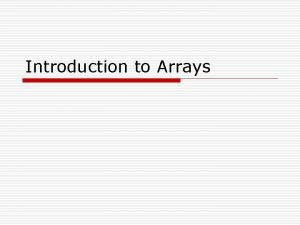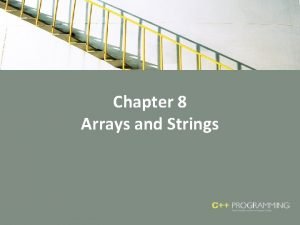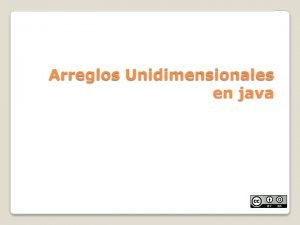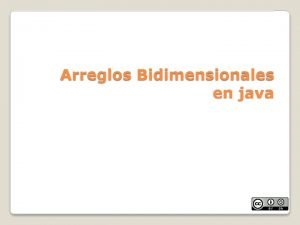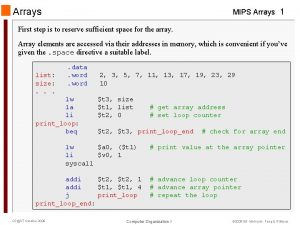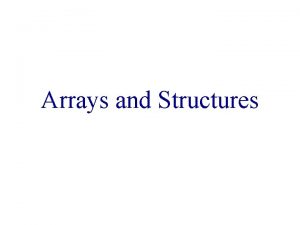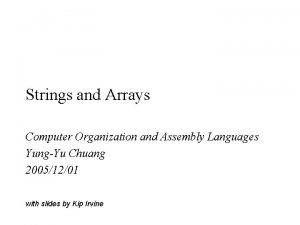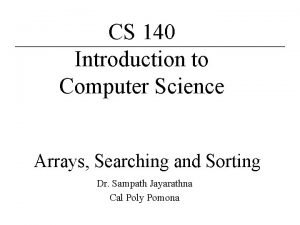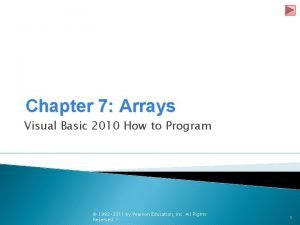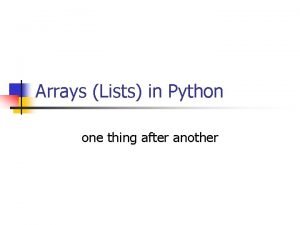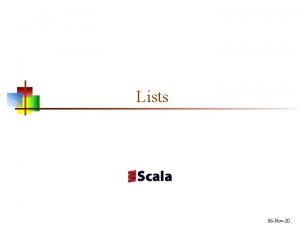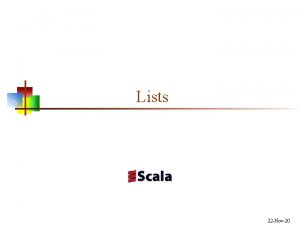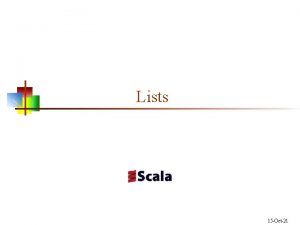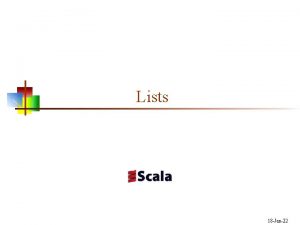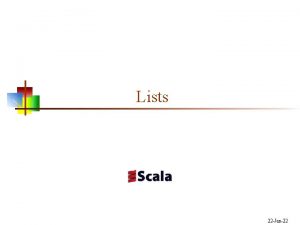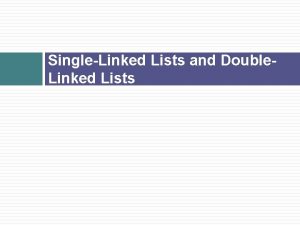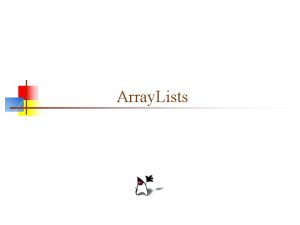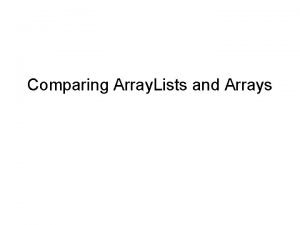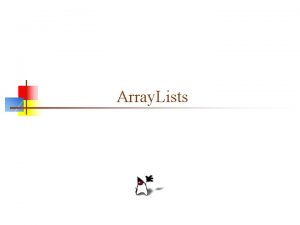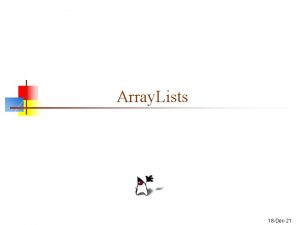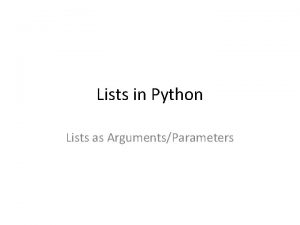CHAPTER 22 LISTS AND ARRAYS 1 Topics C






![List All these methods act on the List ["A", "B", "C", "D"] print( s. List All these methods act on the List ["A", "B", "C", "D"] print( s.](https://slidetodoc.com/presentation_image_h/e705a03402de97e3f5681f7e5561951f/image-7.jpg)

![Array elements are both accessed and assigned via bracket access s. Array[1] = "Bob"; Array elements are both accessed and assigned via bracket access s. Array[1] = "Bob";](https://slidetodoc.com/presentation_image_h/e705a03402de97e3f5681f7e5561951f/image-9.jpg)
![Array All these methods act on the array ["A", "B", "C", "D"] print( s. Array All these methods act on the array ["A", "B", "C", "D"] print( s.](https://slidetodoc.com/presentation_image_h/e705a03402de97e3f5681f7e5561951f/image-10.jpg)
![Multidimensional Arrays can have more than one dimension string[, ] s 2 D = Multidimensional Arrays can have more than one dimension string[, ] s 2 D =](https://slidetodoc.com/presentation_image_h/e705a03402de97e3f5681f7e5561951f/image-11.jpg)


![foreach and Collections Lists and arrays can be iterated over using foreach string[] s. foreach and Collections Lists and arrays can be iterated over using foreach string[] s.](https://slidetodoc.com/presentation_image_h/e705a03402de97e3f5681f7e5561951f/image-14.jpg)



- Slides: 17

CHAPTER 22 LISTS AND ARRAYS 1

Topics C# Collections List – Flexible collection of variable length Array – Standard arrays Multidimensional Arrays Jagged Lists & Arrays foreach and Collections When to Use List or Array Other Collection Types 2

C# Collections A collection in C# is a group of several things that are referenced by a single variable Similar to a pride of lions, parliament of rooks, murder of crows Image from http: //www. quickmeme. com/meme/35 hla 2 3

C# Collections A collection in C# is a group of several things that are referenced by a single variable Similar to a pride of lions, parliament of rooks, murder of crows Two most important C# collections are: – List – Array Both Lists and arrays do appear in the Inspector List is the most flexible and easiest to use, so we'll start with List 4

List Requires a new using line at the top of your script using System. Collections. Generic; List is a generic collection – Generic collections can work for any data type List<string> s. List; List<Game. Object> go. List; // A List of strings // A List of Game. Objects A List must be defined before it can be used (because Lists default to null) s. List = new List<string>(); Elements are added to Lists using the Add() method s. List. Add("Hello"); s. List. Add("World"); 5

List elements are accessed via bracket access – Bracket access is zero indexed (i. e. , starts at [0]) print( s. List[0] ); print( s. List[1] ); // Prints: "Hello" // Prints: "World" Lists have a Count of the number of elements print( s. List. Count ); // Prints: "2" Lists can be cleared of all elements s. List. Clear(); // Empties s. List 6
![List All these methods act on the List A B C D print s List All these methods act on the List ["A", "B", "C", "D"] print( s.](https://slidetodoc.com/presentation_image_h/e705a03402de97e3f5681f7e5561951f/image-7.jpg)
List All these methods act on the List ["A", "B", "C", "D"] print( s. List[0] ); s. List. Add("Apple"); s. List. Clear(); s. List. Index. Of("B"); s. List. Index. Of("Bob"); s. List. Insert(2, "X"); s. List. Insert(4, "X"); s. List. Insert(5, "X"); s. List. Remove("C"); s. List. Remove. At(1); // Prints: "A" // ["A", "B", "C", "D", "Apple"] // [] // 1 ("B" is the 1 st element) // -1 ("Bob" is not in the List) // ["A", "B", "X", "C", "D"] // ["A", "B", "C", "D", "X"] // ERROR!!! Index out of range // ["A", "B", "D"] // ["A", "C", "D"] Lists can be converted to arrays string[] s. Array = s. List. To. Array(); 7

Array is a much simpler collection than List – Does not require any using statement at the top of a script Not actually its own data type, but rather a collection of any data type string[] s. Array; Game. Object[] go. Array; // An array of strings // An array of Game. Objects Arrays are created with a fixed length – Arrays cannot expand to add more elements like Lists can s. Array = new string[4]; // An array of four strings s. Array = new string[] {"A", "B", "C", "D"}; – Either of these arrays will only ever have a Length of 4 8
![Array elements are both accessed and assigned via bracket access s Array1 Bob Array elements are both accessed and assigned via bracket access s. Array[1] = "Bob";](https://slidetodoc.com/presentation_image_h/e705a03402de97e3f5681f7e5561951f/image-9.jpg)
Array elements are both accessed and assigned via bracket access s. Array[1] = "Bob"; // Assigns "Bob" to the 1 st element print( s. Array[1] ); // Prints: "Bob" It's possible to skip elements in an array – The skipped elements are the default value for that type string[] s. Array = new string[4]; // 4 -element string array s. Array[0] = "A"; // ["A", null, null] s. Array[2] = "C"; // ["A", null, "C", null] Arrays have Length instead of Count print( s. Array. Length ); // Prints: 4 – This is similar to strings (which are collections of chars) 9
![Array All these methods act on the array A B C D print s Array All these methods act on the array ["A", "B", "C", "D"] print( s.](https://slidetodoc.com/presentation_image_h/e705a03402de97e3f5681f7e5561951f/image-10.jpg)
Array All these methods act on the array ["A", "B", "C", "D"] print( s. Array[0] ); s. Array[2] = "Cow"; s. Array[10] = "Test"; s. List. Remove("C"); s. List. Remove. At(1); // Prints: "A" // ["A", "B", "Cow", "D"] // ERROR!!! Index out of range // ["A", "B", "D"] // ["A", "C", "D"] Static methods of the System. Array class print( System. Array. Index. Of(s. Array, "B") ); // 1 System. Array. Resize( ref s. Array, 6); // Sets Length to 6 Arrays can be converted to Lists List<string> s. List = new List<string>( s. Array ); 10
![Multidimensional Arrays can have more than one dimension string s 2 D Multidimensional Arrays can have more than one dimension string[, ] s 2 D =](https://slidetodoc.com/presentation_image_h/e705a03402de97e3f5681f7e5561951f/image-11.jpg)
Multidimensional Arrays can have more than one dimension string[, ] s 2 D = new string[4, 4]; s 2 D[0, 0] = "A"; s 2 D[0, 3] = "B"; s 2 D[1, 2] = "C"; s 2 D[3, 1] = "D"; // Makes a 4 x 4 array – This would make the 2 -dimensional array | A | | | D | | | B | | C | | | | – Length is still the total length of the array print( s 2 D. Length ); // Prints: 16 11

Multidimensional Arrays string str = ""; for ( int i=0; i<4; i++ ) { for ( int j=0; j<4; j++ ) { if (s 2 D[i, j] != null) { str += "|" + s 2 D[i, j]; } else { str += "|_"; } } str += "|"+"n"; } print( str ); – This prints: |A|_|_|B| |_|_|C|_| |_|_| |D|_|_|_| 12

Jagged Lists & Arrays Both Lists and arrays can be composed of other Lists or arrays string[][] j. Array = new string[3][]; // Makes a 3 x? array j. Array[0] = new string[4]; j. Array[0][0] = "A"; j. Array[0][3] = "B"; j. Array[1] = new string[] {"C", "D", "E"}; j. Array[2] = new string[] {"F", "G"}; – This would make the jagged array | A | | | B | | C | D | E | | F | G | – Length is now accurate for each part of the jagged array print( j. Array. Length ); print( j. Array[1]. Length ); // Prints: 4 // Prints: 3 13
![foreach and Collections Lists and arrays can be iterated over using foreach string s foreach and Collections Lists and arrays can be iterated over using foreach string[] s.](https://slidetodoc.com/presentation_image_h/e705a03402de97e3f5681f7e5561951f/image-14.jpg)
foreach and Collections Lists and arrays can be iterated over using foreach string[] s. Array = new string[] {"A", "B", "C", "D"}; string str = ""; foreach (string s in s. Array) { str += s; } print( s ); // Prints: "ABCD" List<string> s. List = new List<string>( s. Array ); string str 2 = ""; foreach (string s in s. List) { str 2 += s; } print( s 2 ); // Prints: "ABCD" Why can string s be declared twice? – Because string s is local to each foreach loop 14

When to Use List or Array Each have pros and cons: – List has flexible length, whereas array length is more difficult to change. – Array is very slightly faster. – Array allows multidimensional indices. – Array allows empty elements in the middle of the collection. Because they are simpler to implement and take less forethought (due to their flexible length), the author tends to use Lists much more often than arrays. – This is especially true when prototyping games, since prototyping requires a lot of flexibility. 15

Other Collection Types Array. List – Array. List is like a List except without a set type – Extremely flexible, but I find them less useful and slower Dictionary<key, value> – A key / value pair • The key could be a string, like a username • The value would be the user data – – Used in some of the later tutorials in the book Requires using System. Collections. Generic; Very useful But don't appear properly in the Unity Inspector 16

Chapter 22 – Summary The collections we use in this book can hold any number of objects (of a single type) List is the most easily usable collection type – It requires using System. Collections. Generic; Arrays are less flexible but also very useful – Only arrays can be multidimensional Both Lists and arrays can be jagged I generally recommend Lists over arrays Dictionaries will also be used in this book Next Chapter: Functions! 17
 Dynamic arrays and amortized analysis
Dynamic arrays and amortized analysis Searching and sorting arrays in c++
Searching and sorting arrays in c++ Advantages and disadvantages of array
Advantages and disadvantages of array Parallel arrays in data structure
Parallel arrays in data structure Array of arrays c++
Array of arrays c++ Ragged array
Ragged array Partially filled arrays
Partially filled arrays Parallel arrays
Parallel arrays Why do we need arrays?
Why do we need arrays? Ejemplo de arreglo unidimensional
Ejemplo de arreglo unidimensional Java arreglos bidimensionales
Java arreglos bidimensionales Mips arrays
Mips arrays Polynomial representation using array in c
Polynomial representation using array in c Arrays in arm assembly
Arrays in arm assembly Global arrays in c
Global arrays in c Computer science arrays
Computer science arrays Arrays visual basic
Arrays visual basic Python parallel arrays
Python parallel arrays





